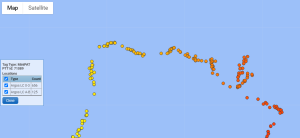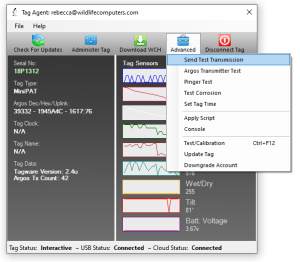19 Dec Tips and Tricks from 2022
Here are all the best tips and tricks from 2022.
Repetition Rates and Animal Behavior: How These Variables Determine Data Transmission
 In Wildlife Computers Argos tags, there is a governing system that specifies how often tags are permitted to transmit. This is referred to as the repetition rate, and it dictates the fastest speed at which a tag can send a satellite transmission.
In Wildlife Computers Argos tags, there is a governing system that specifies how often tags are permitted to transmit. This is referred to as the repetition rate, and it dictates the fastest speed at which a tag can send a satellite transmission.
Although our tags are designed to transmit as soon as they breach the water’s surface, they must obey many parameters, including the repetition rate. If a tag has breached the surface, but less time has passed than the programmed rep rate, the tag will not transmit again. When a tag breaches the surface and an equivalent or longer time has passed than the programmed repetition rate, it will transmit immediately. Both the repetition rate and the breaching of the surface must coincide, in addition to meeting other conditions.
The selection of the proper repetition rate (transmitting every 15 seconds, 30, 45, 60, 90) will depend on the species of animal the individual is tagging. Rates as fast as 15 or 30 seconds require approval from CLS. Some animals, such as turtles and whales, surface for short periods or spend little time at the surface, so repetition rates as fast as 15 seconds may benefit them. Animals that spend more time on the surface or haul out, however, such as pinnipeds, can be programmed with slower repetition rates. A tag’s battery life is affected by the number of transmissions, so an appropriate transmission range must be chosen for the various animal species. The goal is to maximize data throughput and get a precise location when an animal surfaces or hauls out, without overdoing it.
All these items work together to create a location map of all transmissions. When your animal surfaces, and if the tag has reached its repetition rate – the tag will transmit to satellites. Even with the faster rep rates maps will show spatial gaps between locations. How often the animal surfaces, if there are satellites overhead, and the rep rate are all determining factors in getting a location. Irregular spacing between transmissions on a map is normal.
Contact Wildlife Computers if you have questions, or if you would like our recommendations. We can help you select the repetition rate that will maximize the success of your study.
How to Determine Battery Health
 To determine battery health for tags programmed in Tag Agent, you need to look deeper than the tag voltage. This only shows you the tag voltage when there is no stress on the battery. You want to check the voltage when the tag is transmitting as this has the greatest effect on the tag battery voltage. To do this, click “Advanced” on the top toolbar, and select “Send Test Transmission.” This provides the battery voltage when the battery is under stress. It is critical that you do this before deploying your tag to assess the tag’s battery. It isn’t enough to connect to your tag a few times a year, you need to send test transmissions to exercise the battery. When storing your tags you should put your tags in “Stop” or “Shutdown” mode and store them in a cool, dry place.
To determine battery health for tags programmed in Tag Agent, you need to look deeper than the tag voltage. This only shows you the tag voltage when there is no stress on the battery. You want to check the voltage when the tag is transmitting as this has the greatest effect on the tag battery voltage. To do this, click “Advanced” on the top toolbar, and select “Send Test Transmission.” This provides the battery voltage when the battery is under stress. It is critical that you do this before deploying your tag to assess the tag’s battery. It isn’t enough to connect to your tag a few times a year, you need to send test transmissions to exercise the battery. When storing your tags you should put your tags in “Stop” or “Shutdown” mode and store them in a cool, dry place.
Reading Transmit Voltage from Test Transmissions!
When communicating with a MiniPAT using Tag Agent, there’s an optional action to run a Test Transmission. One of the reasons to run a Test Transmission is to check the health of the battery. Tag Agent reports the results, but it also logs the results in the Tag Log in Tag Portal. A logged Test Transmission is shown below for one MiniPAT tag.

The “172 BV” is a representation of the transmission voltage. To convert to voltage, divide the number by 50. In this case, 172 BV = 3.44 v. If this number falls within the range of a healthy battery for MiniPAT tags (≤ 3.3 v), then the battery is fit for deployment.
Test transmissions are crucial to maintaining the health of your MiniPAT tags. MiniPAT batteries develop an electronically insulating layer known as passivation to help with long-term storage. This passivation layer keeps the battery from short-circuiting and discharging on its own but also causes low-voltage readings during startup. Logging into Tag Agent and performing 5-10 test transmissions a month to exercise the batter ensures the battery does not develop a critical amount of passivation.
